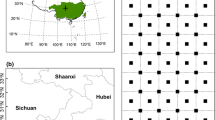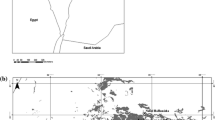Abstract
An observational study of early seedling establishment (first 1–2 summers after emergence) was conducted in four ponderosa pine (Pinus ponderosa var. ponderosa Dougl. ex Laws.) stands east of the Cascade Range crest in central Oregon, USA. Newly emerged ponderosa pine seedlings were identified at the start of summer and were monitored through their second summer; a subsequent cohort of seedlings was identified and monitored for one summer. About 3% of the viable seed that was produced resulted in new seedlings. Mortality was substantial immediately following emergence. Most seedlings emerged without shading from understory vegetation, but few survived. Most seedlings alive after one year had emerged beneath live cover; by the end of two summers only shaded seedlings were alive. 63–85% of new seedlings initiated in clusters attributed to rodent caching, and seedlings originating in clusters remained a substantial proportion of the cohort (60%) after two seasons. Results suggest that understory vegetation in these types of stands facilitates the recruitment of ponderosa pine seedlings, most likely by buffering them against environmental stressors during the seedling establishment phase. They also reveal that seed caching rodents are highly active in seed redistribution and can exert a lasting influence on seedling recruitment.


Similar content being viewed by others
References
Allison PD (1995) Survival analysis using SAS: a practical guide. SAS Institute Inc., Cary, NC, 304 p
Barrett JW (1978) Height growth and site index curves for managed even-aged stands of ponderosa pine in the Pacific Northwest. USDA Forest Service Research Paper PNW-RP-232, 14 p
Bertness MD, Callaway RM (1994) Positive interactions in communities. Trends Ecol Evol 9:191–193
Callaway RM, Walker LR (1997) Competition and facilitation: a synthetic approach to interactions in plant communities. Ecology 78(7):1958–1965
Cochran PH (1970) Seeding ponderosa pine. P. 28–35 in Regeneration of Ponderosa Pine, Oregon State University School of Forestry Paper 681, Corvallis, OR
Eastman WR Jr (1960) Eating of tree seeds by birds of central Oregon. Oregon State University Forest Research Lab Research Note 42, 24 p
Farmer RE Jr (1997) Seed ecophysiology of temperate and boreal zone forest trees. St. Lucie Press, Delray Beach, Florida, 253 p
Fisher PL (1941) Germination reduction and radicle decay of conifers caused by certain fungi. J Agri Res 62:87–95
Fisher RA (1922) On the interpretation of χ2 from contingency tables, and the calculation of P. J R Stat Soc 85(1):87–94
Heidmann LJ (1976) Frost heaving of tree seedlings: a literature review of causes and possible control. USDA Forest Service General Technical Report RM-GTR-21, 10 p
Holmgren M, Scheffer M, Huston MA (1997) The interplay of facilitation and competition in plant communities. Ecology 78(7):1966–1975
Hooven EF (1966) Pine regeneration in Oregon—habits and control of seed-eating mammals. Oregon State University Forest Research Lab Research Paper 5, 24 p
Keyes CR (2000) Natural regeneration of ponderosa pine: pest management strategies for seed predators. Forestry Chron 76(4):623–626
Keyes CR (2002) Recruitment of ponderosa pine seedlings beneath partial overstories. Ph.D. dissertation, Oregon State University, Corvallis, OR, 193 p
Keyes CR, Maguire DA (2005) Positive seedling-shrub relationships in natural regeneration of ponderosa pine. In: Proceedings of the symposium on ponderosa pine: issues, trends, and management. USDA Forest Service General Technical Report PSW-GTR-198, pp. 95–107
Keyes CR, Acker SA, Greene SE (2001) Overstory and shrub influences on seedling recruitment patterns in an old-growth ponderosa pine stand. Northwest Sci 75(3):204–210
Koroleff A (1954) Leaf litter as a killer. J Forestry 52(3):178–182
Lawrence WH, Kverno NB, Hartwell HD (1961) Guide to wildlife feeding injuries on conifers in the pacific northwest. Western Forestry and Conservation Association, Portland, Oregon. 44 p
Pearson GA (1913) Methods of combating seed destroying animals. USDA Rev Forest Service Investig 2:82–85
Roth LF (1970). Disease as a factor in regeneration of ponderosa pine. P. 89–93 in Regeneration of Ponderosa Pine, Forest Research Laboratory, Oregon State University, Corvallis, Oregon
Saigo BW (1969) The relationship of non-recovered rodent caches to the natural regeneration of ponderosa pine. M.A. thesis, Oregon State University, 98 p
Smith CF, Aldous SE (1947) The influence of mammals and birds in retarding artificial and natural reseeding of coniferous forests in the United States. J Forestry 45:361–369
Tappeiner JC, Helms JA (1971) Natural regeneration of Douglas-fir and white fir on exposed sites in the Sierra Nevada of California. Am Midl Nat 86(2):358–370
Vander Wall SB (1992a) Establishment of Jeffrey pine seedlings from animal caches. West J Appl Forestry 7(1):14–20
Vander Wall SB (1992b) The role of animals in dispersing a “wind-dispersed” pine. Ecology 73(2):614–621
Vander Wall SB (1994) Removal of wind-dispersed pine seeds by ground-foraging vertebrates. Oikos 69:125–132
Vander Wall SB (2002) Masting in animal-dispersed pines facilitates seed dispersal. Ecology 83(12):3508–3516
Vander Wall SB (2003) Effects of seed size of wind-dispersed pines (Pinus) on seconday seed dispersal and the caching behavior of rodents. Oikos 100:25–34
Volland LA (1985) Plant associations of the central oregon pumice zone. R6-ECOL-104–1985. USDA Forest Service, Pacific Northwest Region, 138 p
West NE (1968) Rodent-influenced establishment of ponderosa pine and bitterbrush seedlings in central Oregon. Ecology 49(5):1009–1011
Author information
Authors and Affiliations
Corresponding author
Rights and permissions
About this article
Cite this article
Keyes, C.R., Maguire, D.A. & Tappeiner, J.C. Observed dynamics of ponderosa pine (Pinus ponderosa var. ponderosa Dougl. ex Laws.) seedling recruitment in the Cascade Range, USA. New Forests 34, 95–105 (2007). https://doi.org/10.1007/s11056-007-9041-z
Received:
Accepted:
Published:
Issue Date:
DOI: https://doi.org/10.1007/s11056-007-9041-z




